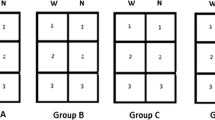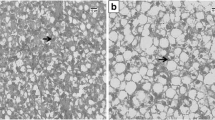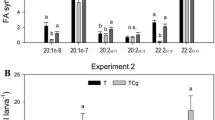Abstract
The total lipid and fatty acid content of 3 algal species,Pyramimonas virginica, Pseudoisochrysis paradoxa andChlorella sp., which have been successful as food sources for rearing larvae of the American oyster,Crassostrea virginica, was determined. Of the fatty acids of ω6 and ω3 families which have been shown to be essential fatty acids for normal growth in many animals, only the ω6 fatty acids were found to be higher in these 3 species of algae than in the traditional oyster larvae diet which consists of the algaeMonochrysis lutheri andIsochrysis galbana. The major fatty acid constituents of the total lipids of the 3 species were the C12, C14, C16 and C18 saturated fatty acids and the C16 and C18 mono- and polyunsaturated acids. These components constituted 70–93% of the total lipid in cultures of all ages. There were modest amounts of C20 and C22 polyunsaturated acids; some of these existed only in trace amounts. InP. virginica andChlorella sp., hexadecanoic acid was dominant (23–39%). The presence of large quantities of tetradecanoic acid (22–26%) and oleic acid (17–21%) was characteristic ofP. paradoxa. Chlorella sp. had the highest proportion of octadecatrienoic acid (18∶3ω3) which accounted for up to 17% of the total lipids. γ-Linolenic acid (18∶3ω6) was found only inChlorella sp., but in the 5th-day culture only. The lowest proportion of total polyethylenic acid was inP. paradoxa; however, lipid analyses showed this alga had the most lipid/individual cell. Some variations were observed in the fatty acid composition with age of the culture.
Similar content being viewed by others
References
Bruce, J.R., M. Knight and M.W. Parke, J. Mar. Biol. Assoc. U.K. 24:337 (1940).
Loosanoff, V.L., and H.C. Davis, in: “Advances in Marine Biology,” Vol. 1, edited by F.S. Russel, Academic Press, London, 1963, pp. 1–136.
Walne, P.R., Fish. Invert. London Ser. II. 26:1 (1970).
Walne, P.R., J. Fish. Res. Board Can. 30:1825 (1973).
Hartman, M., C.E. Epifanio, G. Pruder and R. Srna, Proc. Gulf Carib. Fish. Inst. 29:59 (1973).
Loosanoff, V.L., and T. Murray, Jr., Veliger 16:93 (1974).
Epifanio, C.E., E.M. Logan, and C. Turk, Proc. Eur. Mar. Biol. Symp. 10:97 (1976).
Epifanio, C.E., and C. Mootz, Proc. Natl. Shellfish Assoc., 66:32 (1976).
Ukeles, R., in “Proceedings of the Conference on Artificial Propagation of Commercially Valuable Shellfish,” College of Marine Studies, University of Delaware, 1969, pp. 43–64.
Dupuy, J.L., Marine Technology Society, 9th Annual Conference Proceedings, 1973, p. 677.
Dupuy, J.L., in “Physiological Ecology of Estuarine,” edited by J.F. Vernberg, Univ. S.C. Press, Columbia, SC, 1975, pp. 319–331.
Windsor, N.T., M.A. Thesis, College of William and Mary, Williamsburg, VA (1977).
Flaak, A.R., and C.E. Epifanio, Mar. Biol. 45:157 (1978).
Castell, J.D., and D.J. Trider, J. Fish. Res. Board Can. 31:95 (1974).
Haven, D.S., Chesapeake Sci. 6:43 (1965).
Ingole, R.M., Sea Front 13:296 (1967).
Dunathan, J.P., R.M. Ingole and W.K. Havens Jr., Tech. Ser. Mar. Res. Lab., Fla. Dep. Nat. Res., St. Petersburg 58:1 (1969).
Holland, D.L., and B.E. Spencer, J. Mar. Biol. Assoc. U.K. 53:287 (1973).
Helm, M.M., D.L. Holland and R.R. Stevenson, J. Mar. Biol. Assoc. U.K. 53:673 (1973).
Giese, A.C., Oceanogr. Mar. Biol. 7:175 (1969).
Ackman, R.G., C.S. Tocher and J. Melachlan, J. Fish. Res. Board Can. 25:1603 (1968).
Watanabe, T., and R.G. Ackman, J. Fish. Res. Board Can. 31:403 (1974).
Chuecas, L., and J.P. Riley, J. Mar. Biol. Assoc. U.K. 49:97 (1969).
Otsuka, H., and Y. Morimura, Plant Cell Physiol. 7:663 (1966).
Ackman, R.G., P.M. Jangaard, R.J. Hoyle and H. Brockerhoff, J. Fish. Res. Board Can. 21:747 (1964).
Dupuy, J.L., N. Windsor and C. Sutton, VIMS Spec. Rept. Appl. Mar. Sci. Ocn. Eng., No. 142, 1977, pp. 51–74.
Bligh, E.G., and W.J. Dyer, Can. J. Biochem. Physiol. 37:911 (1959).
Morrison, W.R., and L.M. Smith, J. Lipid Res. 5:600 (1964).
Ackman, R.G., J. Am. Oil Chem. Soc. 42:38 (1965).
Ackman, R.G., J. Am. Oil Chem. Soc. 40:558 (1963).
Appleqvist, L.A., J. Lipid Res. 13:146 (1972).
Barnes, H., and J. Blackstock, J. Exp. Mar. Biol. Ecol. 12:103 (1973).
Kates, M., and B.Z. Volcani, Biochim. Biophys. Acta 116:264 (1966).
Kaneda, T.J., Bacteriol. 93:894 (1967).
Kaneda, T.J., Bacteriol. 98:143 (1969).
Schlenk, J., H.K. Mangold, J.L. Gellerman, W.Z. Ling, R.A. Morrissette, R.T. Holman and H. Hayes, J. Am. Oil Chem. Soc. 37:47 (1960).
Williams, R.V., and R. McMillan, Science 113: 459 (1961).
Klenk, Z., W. Knipprath, D. Zberhagen, and H.P. Koff, Hoppe Seylers Z. Physiol. Chem. 334:44 (1963).
Hulanicka, D., J. Erwin and K. Bloch, J. Biol. Chem. 239–2778 (1964).
Erwin, J., D. Hulanicka and K. Bloch, Comp. Biochem. Physiol. 12:191 (1964).
Tinoco, J., R. Babcock, I. Hincenbergo, B. Medwadowski and P. Miljanich, Lipids 13:6 (1978).
Yu, T.C., and R.O. Sinnhuber, Lipids 7:450 (1972).
Watanabe, T., F. Takashima and C. Ogino, Bull. Jpn. Soc. Sci. Fish. 40:181 (1974).
Watanabe, T., T. Takeuchi and C. Ogino, Bull. Jpn. Soc. Sci. Riwh. 41:263 (1975).
Millar, R.H., and J.M. Scott, J. Mar. Biol. Assoc. U.K. 47:475 (1967).
Collyer, D.M., J. Mar. Biol. Assoc. U.K. 36:335 (1957).
Chu, F.L., K.L. Webb and J.L. Dupuy, Mar. Biol., submitted for publication.
Author information
Authors and Affiliations
Additional information
Contribution No. 883 of the Virginia Institute of Marine Science, Gloucester Point, VA 23062.
About this article
Cite this article
Chu, FL.E., Dupuy, J.L. The fatty acid composition of three unicellular algal species used as food sources for larvae of the American oyster (Crassostrea virginica). Lipids 15, 356–364 (1980). https://doi.org/10.1007/BF02533551
Received:
Issue Date:
DOI: https://doi.org/10.1007/BF02533551




